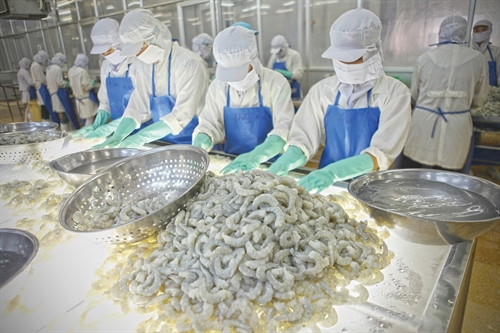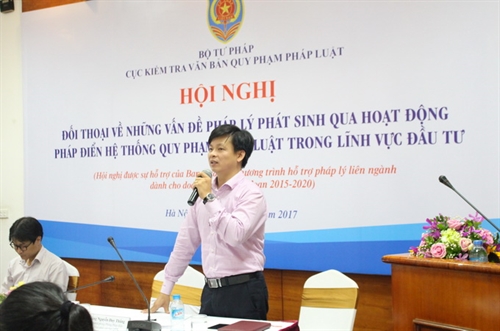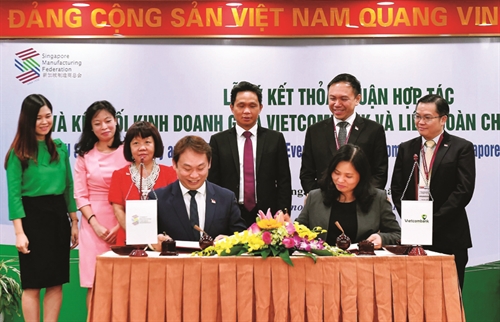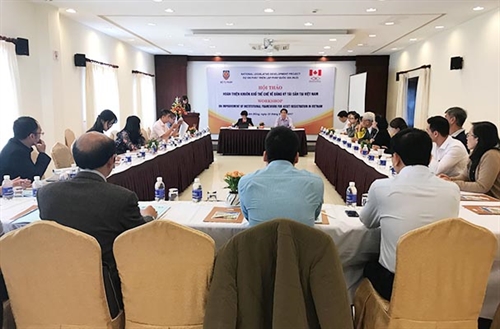This article highlights Vietnam’s regulations on occupational safety and health (OSH), which require enterprises to implement scientific and technical, organizational and administrative measures to eliminate dangerous and harmful factors in workplaces.
Nguyen Tan Hoang Hai and Nguyen Thi Thu Han,
Civil Law Faculty, Ho Chi Minh City Law University
Current situation
Under a prime ministerial decision, from May 1-30, 2017, the Month of Action for OSH was launched for the first time in Vietnam in order to raise the awareness about and enhance compliance with the OSH law nationwide, which was actively responded by a lot of enterprises.
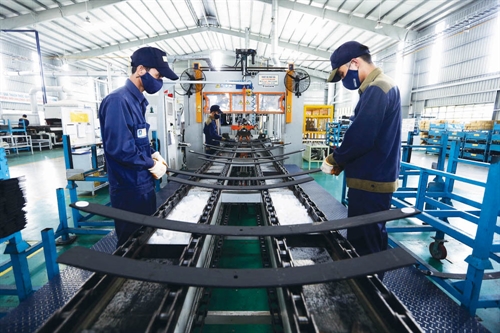 |
| Workers in the automobile leaf spring manufacturing line of Truong Hai Auto Corporation in Quang Nam province__ Photo: Danh Lam/VNA |
Although businesses have attached greater importance to OSH work, occupational accidents still occur at an alarming level[1]. According to reports of 63 provincial-level Departments of Labor, War Invalids and Social Affairs, 4,399 occupational accidents occurred nationwide in the first half of 2017, involving 4,461 victims, including:
+ Number of fatal accidents: 406
+ Number of accidents involving two or more victims: 56
+ Number of deaths: 418
+ Number of seriously injured workers: 843
+ Number female victims: 1,350
The above statistics also reveal that joint-stock companies and the construction sector saw the highest numbers of accidents and deaths, 40.3 percent and 43.9 percent and 25.8 percent and 24.2 percent, respectively.
An analysis of 62 investigation reports on fatal occupational cases shows that the causes on the part of employers account for 33.8 percent[2], specifically:
+ Cases where employers provided no or inadequate occupational safety training for workers: 12.9 percent;
+ Cases where employers failed to develop safe working procedures and methods: 12.9 percent;
+ Cases where equipment failed to meet occupational safety standards: 4.8 percent;
+ Cases due to organizational work and working conditions: 1.6 percent; and
+ Cases where employers did not provide personal safety equipment: 1.6 percent.
At present, administrative violations of the OSH law are sanctioned under Government Decrees 95 of 2013 and 88 of 2015. Inspection results show seven main violations: (i) failing to provide OSH training for workers; (ii) failing to regularly inspect the safety of machinery and equipment subject to strict safety requirements; (iii) failing to provide allowances in kind for workers working in an environment with heavy, harmful or dangerous factors; (iv) failing to appoint an OSH official; (v) failing to make annual OSH plans under regulations; (vi) providing no regular medical checkups for workers or failing to provide regular medical checkups for all workers working in an environment with heavy, harmful or dangerous factors; and (vii) failing to measure harmful factors in the workplace.
Current regulations on OSH measures
To date, Vietnam has ratified or acceded to 21 conventions of the International Labor Organization, including 12 ones directly related to OSH. These conventions require the member states to proactively take steps toward a safe and healthy working environment through adopting appropriate national policies, systems and programs on OSH. International commitments on OSH have been incorporated in Vietnam’s Law on Occupational Safety and Health (OSH Law) and its implementing regulations.
Firstly, regarding responsibility of employers to create a safe and healthy working environment, Article 4.2 of Convention 155 concerning OSH and the working environment states:
“The aim of the policy shall be to prevent accidents and injury to health arising out of, linked with or occurring in the course of work, by minimizing, so far as is reasonably practicable, the causes of hazards inherent in the working environment.”
This provision is concretized in Clause 2, Article 5 of Vietnam’s OSH Law: “Guaranteeing that all occupational safety and health measures are implemented during the working process; prioritizing measures to prevent, preclude and control dangerous and harmful factors during the working process.”
Specifically, dangerous and harmful factors must be eliminated right from the stages of design of workshops and selection of technologies, equipment and materials. Annually, employers must work out an OSH plan, assessing occupational accident and disease risks. They are required to organize environmental monitoring at least once a year[3] for harmful factors. Based on these risks, employers must prepare a plan on emergency response to and handling of technical incidents and guide workers how to assess risks. When workers are clearly aware of occupational accident risks that seriously threaten their lives or health, they are entitled to refuse to work at or leave their workplace while still receiving full pay and not being regarded as breaching working discipline provided that they promptly report such risks to their employer for solution. They can return to their workplace only after their employer and OSH officer have addressed these risks.
Employers may not compel workers to continue working at or return to the workplace when there emerges an occupational accident risk seriously threatening their lives or health.
The difference between Convention 155 and the OSH Law is that Article 5 of the Convention stipulates that workers are entitled to refuse to work at or leave the workplace when they can “prove the imminent danger”, while Article 6.1.dd of the OSH Law uses the phrase “clearly aware of an occupational accident risk”.
In case there remain some dangerous and harmful factors, measures must be taken to prevent and limit exposure to them, such as developing a working process, implementing labor protection regimes, procuring and equipping personal protection devices for workers working in contact with one of these factors. Employers must pay for all of labor protection devices[4].
Equipment subject to strict OSH requirements must be closely managed. The use and disposal of machinery, equipment and supplies of this kind must be reported to provincial-level authorities to ensure compliance with technical regulations. In addition, all machinery, equipment and supplies subject to strict OSH requirements must be inspected before and during use with a view to timely detecting damaged or breakable parts that might affect at any time the health or life of workers. While in use, dangerous parts of machinery and equipment must be covered to prevent incidents. OSH instruction signs must be placed at noticeable places in workplaces and areas where such machinery and equipment are installed so as to help workers avoid occupational accident risks.
Besides, employers must provide in-kind allowances for workers working in workplaces with dangerous or hazardous elements. According to Article 2.1 of the Ministry of Labor, War Invalids and Social Affairs’ Circular No. 25/2013/TT-BLDTBXH dated January 18, 2013, a worker is entitled to in-kind allowances if he fully meets two conditions: (i) doing a job on the list of heavy, hazardous and dangerous jobs or of extremely heavy, hazardous and dangerous jobs issued by the Ministry of Labor, War Invalids and Social Affairs; and (ii) working in an environment with at least one dangerous or hazardous factors below the hygiene standards established by the Ministry of Health, or in direct contact with infectious sources.
Article 3.4.b of the above-said Circular additionally stipulates that employers may consider and decide to provide in-kind allowances at level 1 (VND 10,000) for workers who perform a job not on the list of heavy, hazardous and dangerous jobs but works in an environment with at least one dangerous or hazardous factors below the hygiene standards established by the Ministry of Health, or in direct contact with infectious sources. However, providing in-kind allowance in this case is not compulsory for employers.
Secondly, OSH training constitutes one of the most important measures to minimize risks and costs and ensure safety in production activities as well as in the prevention and control of occupational accidents and diseases. Article 19d of Convention 155 stipulates that workers and their representatives must be given appropriate training in OSH. Article 14 of the OSH Law requires employers to organize OSH training either by themselves or a hired training institution[5].
Trainees include both employers and workers divided into six categories: OSH managers; OSH officers; workers performing jobs subject to strict OSH requirements; all workers; health staffs; and safety and hygiene workers. Depending on their tasks and roles, each group will be trained in different issues and for different periods.
Thirdly, concerning workers’ health, Article 5.2 of Convention 187 on the Promotional Framework for Occupational Safety and Health of 2006 stipulates that member states must promote safety and health for workers. The OSH Law contains some specific provisions on this issue. Accordingly, workers must base themselves on the health standards set for each occupation or job and health examination results to arrange appropriate jobs for workers. Employers must organize medical checkups at least once a year for workers, even for job trainees and apprentices. Workers performing heavy, hazardous or dangerous jobs, and workers with disabilities, minor and senior workers must be provided with medical checkups at least once every six months; female workers must be given obstetrical and gynecological examinations; and workers working in contact with risky elements must be given medical checkups for occupational diseases. All these medical costs are to be paid by employers.
Besides, workers performing heavy, hazardous or dangerous jobs and poor-health workers are entitled to convalescence care. However, for the time being, businesses are just encouraged to organize such care for their workers.
Fourthly, in order to properly prevent and control occupational accidents and diseases and ensure the materialization of OSH policies, employers are required to form a unit in charge of OSH matters in their businesses.
Depending on their size, operation, risks of occupational accidents and diseases and working conditions, businesses must satisfy different requirements on the OSH unit as demonstrated in the following table:
| Size of business | Requirements | Requirements on safety officer |
| Under 300 workers | At least 1 part-time OSH officer | Possessing a university degree in an engineering specialty; or a college degree in an engineering specialty and having at least 1 year of experience working in the field of business and production of the business; or an intermediate degree in an engineering specialty or directly perform technical work, and having 3 years of experience working in the field of business and production of the business. |
| Between 300 and under 1,000 workers | At least 1 full-time OSH officer | Possessing a university degree in an engineering specialty and having at least 1 year of experience working in the field of business and production of the business; or a college degree in an engineering specialty and having at least 3 years of experience working in the field of business and production of the business; or an intermediate degree in an engineering specialty or directly perform technical work, and having 5 years of experience working in the field of business and production of the business. |
| Over 1,000 workers | At least 2 full-time OSH officers |
The OSH unit has the duty to advise and assist the employer in organize OSH work. In case an employer cannot find appropriate persons or set up an OSH unit, he must hire a qualified organization to perform OSH tasks under regulations.
Recommendations
The OSH Law was enacted on June 25, 2015, and took effect on July 1, 2016; meanwhile Decree 88 was issued on October 7, 2015, and took effect on November 25, 2016, which adds violations in labor and OSH. However, there are violations of the OSH Law which Decree 88 does not stipulate sanctions. Therefore it is necessary to review and revise Decrees 95 and 88 to conform with the OSH Law.
First, although the OSH Law requires employers to make annual OSH plans, currently there is no sanction against enterprises that fail to make such plans.
Second, according to the regulations on management of workers’ health, employers must compile and manage health records of workers and workers with occupational diseases. However, current regulations on handling of administrative violations related to OSH only provide sanctions against those employers who fail to compile separate health records for workers with occupational diseases.
Therefore, it is necessary to add sanctions against employers who fail to make OSH plans and health records for their workers.
Third, providing in-kind allowances for workers who perform a job not on the list of heavy, hazardous and dangerous jobs but works in an environment with at least one dangerous or hazardous element below the required hygiene standards or in direct contact with infectious sources should be prescribed as a compulsory responsibility of employers.-
